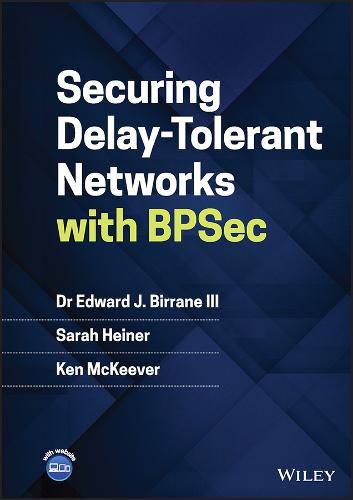Readings Newsletter
Become a Readings Member to make your shopping experience even easier.
Sign in or sign up for free!
You’re not far away from qualifying for FREE standard shipping within Australia
You’ve qualified for FREE standard shipping within Australia
The cart is loading…






Securing Delay-Tolerant Networks with BPSec answers the question Ahow can delay-tolerant networks be secured when operating in environments that would otherwise break many of the common security approaches used on the terrestrial Internet today.A This book is decomposed into three sections: (1) security considerations for delay-tolerant networks, (2) the design, implementation, and customization of the BPSec protocol, and (3) how this protocol can be applied, combined with other security protocols, and deployed in an example case study
The first section presents the challenges of securing disrupted networks. The section starts with a distinction between cryptography as a discipline and the security protocols used to exchange cryptographic materials. This is followed by a discussion of the unique stressors found in DTNs and how these stressing conditions break many of the protocols used to secure the terrestrial Internet. Finally, this section discusses the characteristics of a security architecture for DTNs and the unique security considerations.
The second section focuses on the history and development of the BPSec protocol itself. Next, the mechanisms used to represent cryptographic materials in bundles are discussed along with rules used for the processing of BPSec materials. This section concludes with a discussion of two characteristics of the BPSec protocol: security context definitions and out-of-band policy configurations.
The third section discusses pragmatic considerations for deploying BPSec in both regular and delay-tolerant networks. This section discusses how BPSec interacts with both DTN and non-DTN protocols and how the protocol can be extended to encounter a variety of methods for defining and communicating cryptographic material. This is followed by a series of use cases illustrating the function of BPSec in a network and a tutorial on how to achieve important security outcomes with a combination of security protocols, BPSec included. The section concludes with both a discussion of security concerns and a case study for securing cislunar communications.
$9.00 standard shipping within Australia
FREE standard shipping within Australia for orders over $100.00
Express & International shipping calculated at checkout
Securing Delay-Tolerant Networks with BPSec answers the question Ahow can delay-tolerant networks be secured when operating in environments that would otherwise break many of the common security approaches used on the terrestrial Internet today.A This book is decomposed into three sections: (1) security considerations for delay-tolerant networks, (2) the design, implementation, and customization of the BPSec protocol, and (3) how this protocol can be applied, combined with other security protocols, and deployed in an example case study
The first section presents the challenges of securing disrupted networks. The section starts with a distinction between cryptography as a discipline and the security protocols used to exchange cryptographic materials. This is followed by a discussion of the unique stressors found in DTNs and how these stressing conditions break many of the protocols used to secure the terrestrial Internet. Finally, this section discusses the characteristics of a security architecture for DTNs and the unique security considerations.
The second section focuses on the history and development of the BPSec protocol itself. Next, the mechanisms used to represent cryptographic materials in bundles are discussed along with rules used for the processing of BPSec materials. This section concludes with a discussion of two characteristics of the BPSec protocol: security context definitions and out-of-band policy configurations.
The third section discusses pragmatic considerations for deploying BPSec in both regular and delay-tolerant networks. This section discusses how BPSec interacts with both DTN and non-DTN protocols and how the protocol can be extended to encounter a variety of methods for defining and communicating cryptographic material. This is followed by a series of use cases illustrating the function of BPSec in a network and a tutorial on how to achieve important security outcomes with a combination of security protocols, BPSec included. The section concludes with both a discussion of security concerns and a case study for securing cislunar communications.